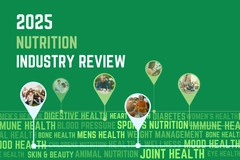
- Industry news
Industry news
- Category news
- Reports
- Key trends
- Multimedia
Multimedia
- Journal
- Events
- Suppliers
Suppliers
- Home
- Industry news
Industry news
- Category news
- Reports
- Key trends
- Multimedia
Multimedia
- Events
- Suppliers
Suppliers
Microbiota, HRB strains and emerging markets spotlighted for infant nutrition

11 May 2023 --- Infant nutrition experts have spotlighted an insatiable interest in products that enhance microbiota health and human-residential bifidobacteria (HRB) strains. NutritionInsight interviewed Morinaga Milk, Chr. Hansen, FrieslandCampina Ingredients, Proactive Health by Kerry, DSM and AFI to get to the pulse of science driving innovation in the space.
Getting the right amount of high-quality nutrients is particularly important for babies in their first 1,000 days of life to their second birthdays. “Ingredients like omega 3 docosahexaenoic acid (DHA), omega-6 arachidonic acid (ARA) and human milk oligosaccharides (HMOs) can play a vital role in supporting a baby’s development,” says Jim Richards, head of nutrition science and advocacy at DSM.
DHA and ARA play a central role in brain and visual development. A growing body of evidence demonstrates their potential benefits when used together in infant nutrition. Opportunities to explore more sustainable sources, such as algal-based fermented nutritional lipids, are imminent.
Innovation frontrunners
Consumers of infant milk formulas consider the presence of probiotics an essential requirement. “Increasingly, parents are seeking products that use probiotics, especially APAC consumers,” says Chyn Boon Wong, assistant manager, marketing and scientific affairs at Morinaga Milk.
“It is an essential ingredient to ease digestion, improve nutrient absorption and promote a balance of bacteria in infants’ guts. Probiotics bifidobacteria, particularly those of species that are the natural inhabitants of the gut, better known as human-residential bifidobacteria, are prized,” Boon Wong explains.
HRB probiotics add natural value to the product. They are scientifically reported as the natural inhabitants of human hosts that are highly compatible with humans. “Building on the scientific evidence, HRB strain like B. longum BB536 has been shown to be a predominant species in infant gut microbiota that play an essential role in infantile development,” says Boon Wong. Bifidobacteria-dominant gut microbiota has gained significant recognition as a contributor to long-term health.
Bifidobacteria-dominant gut microbiota has gained significant recognition as a contributor to long-term health.
“The ubiquitous distribution of B. longum species across the human lifespan was suggested to be associated with their genetic diversity, which could enhance their adaptation and increase competitiveness in the gut environment. BB536 is a key representative strain of B. longum species,” she explains.
BB536 also has a solid capacity to produce indole-3-lactic acid, an important tryptophan metabolite that plays a crucial role in immunomodulation during early life. Moreover, BB536 can produce a high level of folate, verified through several in vitro and in vivo studies.
According to Anne Staudt Kvist Kvistgaard, head of nutrition science at Arla Foods Ingredients, the most exciting breakthrough has been the introduction of patented milk fractionation technology. “It separates fresh milk into specific pure proteins, lactose and fat components, enabling us to create organic infant formula products as finished formulas and base powders.”
FrieslandCampina Ingredients’ Early Life Nutrition – Vision 2023 deduced that consumer demands were in a transformative phase. “As Generation Z become parents, attitudes are changing – mental well-being is one area expected to define parenting trends in the future,” says Sophie Nicolas, global marketing manager, early life nutrition, FrieslandCampina Ingredients.
Blossoming microbiota
The development of bifidobacteria-dominant gut microbiota in early life is increasingly recognized as a significant contributor to short- and long-term health. Bifidobacteria are among the first microbes to colonize an infant’s gut and among the most important determinants of healthy gut microbiota in early life.
“However, not all bifidobacteria are the same,” Boon Wong assures. Recent advances in bifidobacterial research reveal that bifidobacterial strains have coevolved with their hosts and many physiological characteristics can be residential-origin dependent.
HRB species, including B. longum, B. breve and B. infantis, are naturally selected by human breast milk; they retain the superior metabolic capability to use HMOs and produce beneficial metabolites such as folate and aromatic lactic acids. HRB species can therefore better adapt to the infants’ guts.
“With approximately 70% of the immune system being active in the gut, supporting its maturation and keeping it balanced is key to supporting an infant’s immune system,” says Nicholas.
Emerging markets and innovation New parents are showing heightened interest in omega 3s.
New parents are showing heightened interest in omega 3s.
HMOs represent the most significant compositional gap between breast milk and most infant formulas. While HMO concentrations in breast milk differ and vary based on lactation stages, recent DSM-commissioned research reveals that total HMO concentrations are 17.7 g/L in colostrum, 13.3 g/L in transitional milk and 11.3 g/L in mature milk.
“Recent technological advancements have allowed HMOs to be synthetically added to formula and growing awareness of these ingredients has revolutionized innovation in the infant nutrition market,” says Richards.
Existing pre-clinical and clinical research shows HMOs encourage good gut bacteria growth, promote intestinal barrier health and support immune regulation and function.
DSM’s GlyCare HMO portfolio and its latest regulatory approvals for 3-FL in the US and Australia have further boosted access to these next-generation ingredients. “We’re also expanding industry knowledge of HMOs’ potential health benefits, modes of action and applications,” Richards says.
The most important attributes for parents shopping for formula are quality, health benefits and brand reputation. “Awareness of, and preference for, particular ingredients varies significantly by region, with Chinese parents in particular highly knowledgeable about lactose, probiotics, prebiotics, lactoferrin and whey proteins,” says Anne Staudt Kvist Kvistgaard, head of nutrition science at Arla Foods Ingredients.
The composition of breast milk has been a key research area for developing formulas. “The combination of HRB probiotics with prebiotics such as HMOs is an emerging trend in the infant formula industry, while more efforts are needed to bring infant formula closer to breast milk with gut and immunity effects,” explains Boon Wong.
China and the US are the biggest milk formula markets, while India is one of the fastest-growing. The demand for infant milk formula in China accounts for almost half the global market size.
Boon Wong explains: “Growth in China’s infant milk formula market is driven by value and premiumization rather than volume. The low volume growth prospects expected in infant milk formula call for innovation from brands to sustain value growth.”
“Manufacturers started to join the probiotics game, scrutinizing the strain that works best for infant health and stands out of the crowd yet is easy to manage in the manufacturing process and compatible with other ingredients in the infant formula,” she adds.
Precision fermented omega 3s
FrieslandCampina Ingredients has been using precision fermentation since 2016 to produce HMOs and is pursuing this further through its strategic partnership with TripleBar, a biotechnology company specializing in bioengineering to develop solutions for the nutrition and healthcare industries.
“We’ll produce microbial cells through precision fermentation to create bioactive proteins that support human nutrition and health in early life. The process will allow us to precisely draw out components from milk,” says Nicolas.
Precision fermentation isn’t the only technology the company is leveraging. “Our cutting-edge encapsulation process encloses droplets of omega 3 LCPUFA-containing oils in a powder matrix.”
The process makes them easier to mix with other dry ingredients in infant formula, extends the shelf life and improves the sensory properties of the final product by dispelling odors and off-tastes caused by oxidation.
Probiotics and branded strains Research shows it is vital that infants receive the right nutrients for the first two years of life.
Research shows it is vital that infants receive the right nutrients for the first two years of life.
Global consumers are highly aware of probiotics’ benefits for immune health. “Innovations in this space include LC40, the first probiotic strain isolated from human breast milk. It’s clinically backed, with three randomized, double-blind trials showing it can help cut the risk of infection in infants,” says Alexandra Boelrijk, global RD&A senior director at ProActive Health by Kerry.
In babies delivered by Cesarean section, which can compromise immune system development, LC40 reduces gastrointestinal infections by up to 73% and decreases the incidence of respiratory infection.
Parents are also more interested in DHA and eicosapentaenoic acid (EPA), omega 3 essential fatty acids.
“There are over 2000 clinical studies evidencing their benefits for human health, with DHA known to contribute to infants’ retinal and cognitive development. Eupoly-3 DHA Infant is a natural source of omega 3 fatty acids designed for infant nutrition, with 25% DHA content and exceptional technological and organoleptic properties,” says Boelrijk.
“In addition, co-branding with a clinically evidenced, branded ingredient is an effective way to differentiate products on the shelves.”
Branded ingredients from trusted companies can increase consumer confidence in infant nutrition. “We have just been given EU safety approval for our milk protein hydrolysate, Peptigen IF-3080. It’s only one of a handful of such products to achieve this status and can now be used in infant formulas and follow-on formulas throughout the EU,” explains Staudt Kvist Kvistgaard.
Adding HMOs to infant formula allows infant formula to have functional properties closer to breast milk, improving health benefits for formula-fed infants. “Scientific studies show that HMOs’ diversity and natural levels are key to realizing their potential in infant nourishment,” says Yannik Schoenknecht, scientific advisor, HMO at Chr. Hansen.
In addition, probiotic strains that are central to the healthy infant microbiome are key. “These bacteria in the infant microbiome break down, supply essential nutrients and support the infants’ gastro, immune and neurological systems development,” says Schoenknecht.
Regulatory approval issues
Infant formula is one of the most regulated product areas. Branded ingredients assure the end consumer of the quality and stable content of the ingredients.
DSM recommends striking the right balance between DHA and ARA intake to ensure infants across the globe achieve optimal growth and development. Approximately 25-75% of the population carries a variation in the fatty acid desaturase (FADS) gene globally that limits their ability to synthesize DHA and ARA.
“ARA synthesis is disproportionately affected, with up to 28% of the variation in ARA blood levels attributed to FADS polymorphisms,” explains Richards. “While EU regulation makes it mandatory to add DHA to infant formula, ARA remains an optional ingredient. The regulation has caused controversy throughout the infant nutrition market and the scientific community.”
“This is largely due to the lack of scientific evidence demonstrating the safety and nutritional suitability of supplying DHA alone – deviating tremendously from the composition of breast milk, which contains both ARA and DHA – and uncertainty regarding the possibility of risks”.
“To ensure infant nutrition products are safe and effective, experts have called for the inclusion of both DHA and ARA in infant and follow-on formula in a ratio of 1:1 to 1:2 to mirror the composition of these components in breast milk,” Richards outlines.
By Inga de Jong











